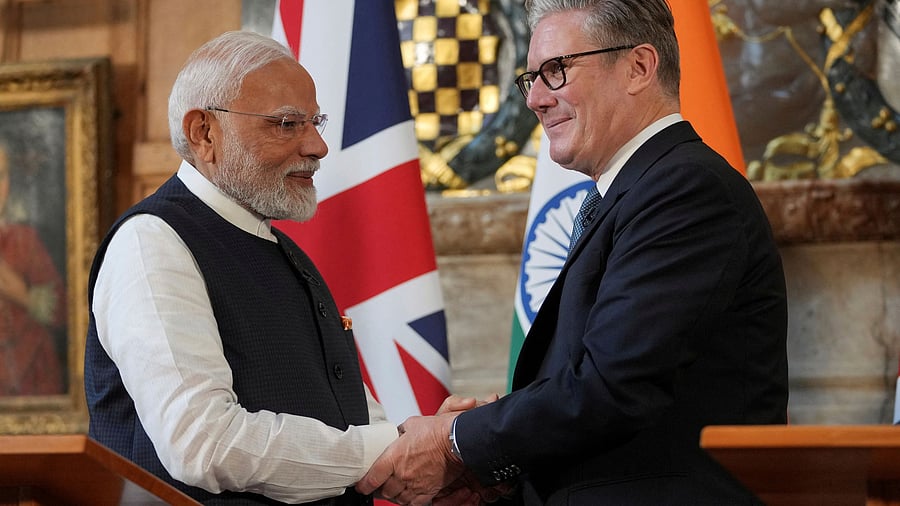
Britain's Prime Minister Keir Starmer and Prime Minister Narendra Modi of India shake hands after signing a free trade agreement at Chequers near Aylesbury, England, Thursday, July 24, 2025.
Credit: Reuters Photo
Some of the major outcomes of Prime Minister Narendra Modi’s visit to the United Kingdom include the India-UK Comprehensive Economic and Trade Agreement (CETA), the launch of the India-UK Vision 2035, a new Defence Industrial Roadmap, and an agreement to negotiate a double taxation convention. While Vision 2035 builds upon and upgrades the earlier Roadmap 2030, the primary focus has been on the CETA.
The deal is a game changer, marking a crucial FTA with a developed economy — following agreements with Japan, Australia, and the EFTA nations. India has also crossed several of its traditional red lines, including opening the automobile sector and government procurement. This reflects the growing maturity of the Indian economy and the confidence of its policymakers. Although negotiations with the European Union (EU) and the United States have their own dynamics, the CETA serves as a useful template, indicating how far India is willing to go in trade negotiations.
The Indian media has widely reported on the benefits of the CETA, particularly the fact that nearly 99% of Indian goods will now enter the UK tariff-free. Key sectors such as textiles, leather, footwear, sports goods, and toys, marine products, gems and jewellery, engineering goods, auto parts and engines, and organic chemicals are expected to benefit significantly.
On its part, the UK government has described the CETA as the “biggest and most economically significant new bilateral FTA” since Brexit. For the UK, the agreement eliminates or reduces tariffs on 90% of tariff lines over the next 10 years. This includes major UK exports such as whisky and gin. British cars will also see a phased reduction in tariffs from 110% to 10% within specific quotas.
Clearly, both governments saw mutual benefits in the deal, which is why they agreed to sign it. However, one must keep in mind that the average MFN tariffs in the UK are around 3%, compared to India’s average of about 13%. If most of these tariffs are significantly reduced, even if phased over several years, the UK is likely to gain more in the goods sector in the long run. It is, therefore, expected that these concessions have been balanced by securing greater advantages for India in services or other areas.
In services, both India and the UK are highly competitive, and the CETA could prove mutually beneficial. Both sides expect significant gains. Indian companies will gain greater market access in IT and IT-enabled services, financial and legal services, as well as professional and educational services. Similarly, British companies offering financial, environmental, and construction services are also anticipating improved opportunities in the Indian market.
Despite the adverse political environment surrounding migration in the UK and Europe, the CETA and the accompanying social security co-ordination may create new opportunities for short-term mobility of Indian professionals. The earlier 'Graduate Visa' scheme allowed Indian students to work for two years after completing their degrees. Under the new post-Brexit immigration system introduced in 2021 — with high skills and salary thresholds — many highly skilled Indian workers have entered the UK, particularly in the ICT, health, and care sectors. This aligns with the Indian government's strategy to position India as a global hub for skilled manpower and to promote the overseas mobility of Indian workers.
The opening of the automobile sector could be tricky. Some safeguards have been introduced. These include a phased approach over a few years and quota limits for each segment. Still, even 25,000 imported cars could affect some domestic manufacturers, especially in the luxury segment. The EU, and the US, may also demand similar quotas in future trade talks with India.
Full chapters on labour, environment, gender equality, State-owned enterprises, and development co-operation not only make the agreement truly comprehensive but also indicate that India is now comfortable including these so-called non-trade issues in trade agreements.
India’s relatively bold approach to the UK FTA marks a step into new territory. It may reflect growing confidence in the maturity of its economy and manufacturing sector. If so, this is good news — not just for the EU and the US. It also strengthens the case for India’s future engagement with major trade deals like the Regional Comprehensive Economic Partnership and the Comprehensive and Progressive Agreement for Trans-Pacific Partnership.
(Gulshan Sachdeva is chief coordinator, DAKSHIN-Global South Centre of Excellence at the RIS New Delhi, and Professor of European Studies at Jawaharlal Nehru University.)
Disclaimer: The views expressed above are the author's own. They do not necessarily reflect the views of DH.